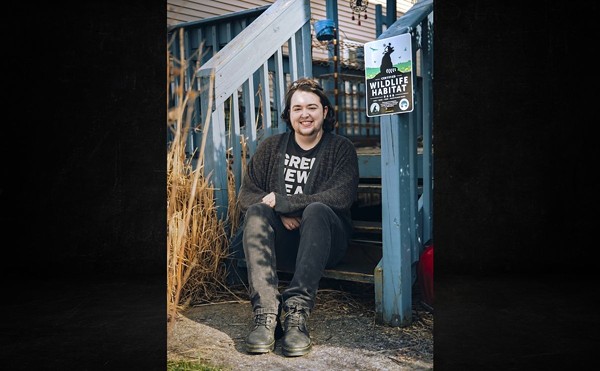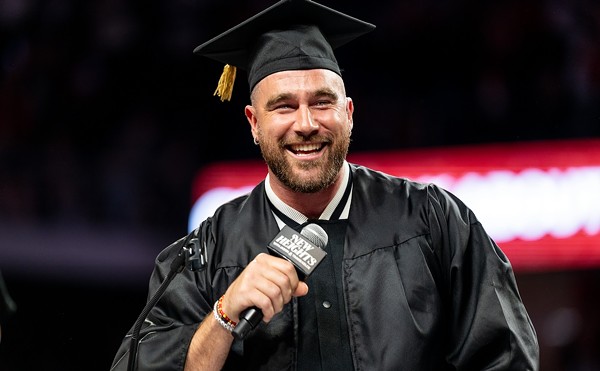|
Down in the Valley is a cowboy movie where all the sodbusting occurs inside a 16-year-old girl's bathing suit. But this film accomplishes way more than just a little mismatched hubba-hubba — it also manages to create a latticework of well-intentioned conflict, which it then abandons for a creaky postmodern trip through fractured identity and embattled machismo.
Tobe (Evan Rachel Wood), short for "October," is the aforementioned teen. At the outset of Down in the Valley, she's looking to clear her head a little. She doesn't live in a slum, but the sprawldom of outer Los Angeles has its own petty ugliness. The film imparts this delicately, with downer browns and underlit interiors butting up against the vista of gas stations and strip malls out in the white-yellow heat.
Tobe's single father, Wade (David Morse), is a ball of repressed anger. He might not ever get down to hitting the kids, but there's a cloud of concerned rage girding his throbbing temples, like a laurel wreath woven from withheld spankings.
So Tobe just wants to get away for a little while. Take a nice walk out in the world.
Get a little fresh air. Only in Los Angeles, "fresh air" and "the world" translate to a pedestrian overpass spanning a freeway. Mmmmm! Ozone and freedom!
Accompanying Tobe is her sullen younger brother, Lonnie. The very picture of neurotic adolescence, he's afraid of the dark and flat of affect, and he probably smells like old pajamas. Lonnie's portrayed by yet another Culkin brother, but I can't remember which one. Shawn, maybe. Or Keenan Ivory. (It's actually Rory.)
When Tobe returns home, she starts arguing with Dad about going to the beach with some friends. Her friends arrive, and she rushes out. When they fill up at a gas station, they meet Harlan, played by Edward Norton. Tobe's friends immediately start poking fun at him, and it's not hard to see why.
Going beyond the instinctive mockery that anyone over 30 provokes in teenagers, Harlan's cowboy hat and archaic courtliness show a man unconcerned with Fonzie-born notions of "cool." Still, with very little exposition in the opening scenes, writer/director David Jacobson works a masterful subtlety, making Tobe's attraction to Harlan seem like a believable development (if not a explicitly described one). With his anachronistic airs, his put-on drawl and assumed calm, he's a rejection of everything that Tobe's dying to escape from.
Not much insight is required to paint suburban America as the place where the American Dream has found its hollow bloom, but Jacobson does something interesting with this haggard conceit. Harlan's pretensions don't seem to be in conflict with his surroundings, but rather completely unaware of them.
Similarly, as Jacobson's camera lopes across the San Fernando Valley, it doesn't seem to notice the expanses of asphalt and puked-up overdevelopment. With long, swooping shots of a river of cars flowing down the highway and the hedges of postage-stamp lawns — as if they were the open range of old — Jacobson puts modern suburbia in the same orbit as Harlan's dude-ranch playacting. This washes the cliché out of his critique, leaving just enough of a sting for it to register.
So Harlan and Tobe start dating. At one point, he looks up at her on a tree swing, and asks, "You think things have a purpose?" With each motion, it's clear that his entire life is an act of storytelling. Jacobson hammers the point home during a scene where Harlan is alone in his living room, pretending to be a cowboy engaged in a final shootout from behind his Barcalounger. Since he's playing pretend all by himself, it's pretty clear he's not a con man, just a big old goof. Of course, just because he's a big old goof, that doesn't mean he's not also a perilously deluded psychopath!
We hope that's not the case — not just for Tobe's sake, but for ours, too — because without the tired old schizophrenic avenger nonsense, Down in the Valley is an intriguing tangle of reasonable conflicts. Tobe loves Harlan and feels liberated by his prairie naiveté. Harlan is obviously smitten with his little lady.
For his part, Wade is awfully mistrustful of Harlan, and who can blame him? Who does this strip mall Roy Rogers think he is, and who said Wade's daughter could be his trusty mount? The collision of these understandable resentments — with Harlan at the center of it all, simultaneously smoothing things over and roiling them up — makes for a provocative story with a light touch.
Unfortunately, it doesn't last. With a fanfare of crappy trumpets, it becomes clear that, yes, Harlan's just another criminal escaping a murky childhood through the magic of self-deception. Jacobson doesn't surrender his sensitivity and sure-footed filmmaking, but suddenly it feels like he's taunting us with reminders of the potential that Down in the Valley started out with.
At first, the film's motion came out of the cold war between Harlan's earnest put-ons, Wade's protective Papa Bear act and Tobe's struggle with the promise of Harlan's fantasies. Jacobson's superb first act calls for something quieter and better than this unraveling ending, where everything comes down to lies and gunfights. Grade: C+





